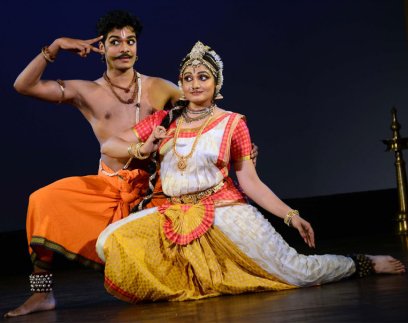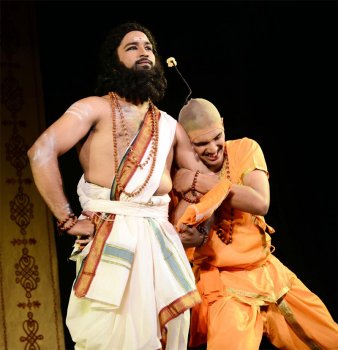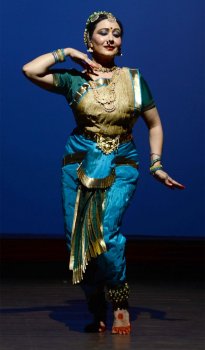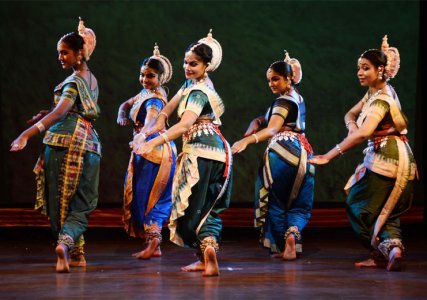
|   |

|   |
Nrityanjali Festival 2015 - Poornima Gururaja e-mail: poornima.g84@gmail.com March 11, 2015 Poornima Ashok, Director Nrityanjali, Bangalore, hosted the Nrityanjali dance festival at Seva Sadan, Malleswaram, on the 22nd and 23rd February 2015. Thirty odd years of learning and 25 years of teaching have gone into shaping what Nrityanjali is today. A performer of repute, Poornima Ashok also nurtures a heart to share stage space with other artists of calibre, year after year. The first day’s performances this year were both dance dramas that highlighted gender issues. The opening performance was an adaptation of ‘Bhagavadajukeeyam,’ a well known Sanskrit play. The lyrics were penned by Dr. Shatavadhani R. Ganesh in Kannada and the music set by Praveen D Rao. Humour, as difficult as it is to bring out in classical dance plays was brought out effectively through the choreographic skills of senior dancer and guru Ashok Kumar. The play opened with a colourful depiction of spring with peacocks and deer in appropriate costumes. The ode to Madana penned by Dr. Ganesh was as much of an aural treat as the rest of the dialogues during the play. After a brief introduction of Ramila and Vasanthasena, the next few songs with Vasanthasena as the central character easily flowed from a virhotkantita nayika to a vasakasajja, an abhisaarika and swadeenapathika nayikas. The use of the veil and the lamps by the sakhis in the background added to an impressive portrayal. 

Anil V Iyer transitioned easily between the roles of the guru and the role with misplaced soul of Vasanthasena in his body. His gesticulation of male and female roles was distinctly different and apt. He easily stole the show. Other noteworthy performances were Shruthi Suresh as Vasanthasena and Anup as Shadilya, the shishya only interested in worldly matters and women. Gender roles were exchanged because of interchange of a woman’s soul in a man's body and man's soul in a woman’s. The colourful and tasteful costuming, involved performances by the sakhis and the built in humour entertained a packed audience. It was as interesting to watch the audience double over in laughter as it was to watch the play unfold crisply scene after scene. Samanvaya Dance Company’s production ‘Chitrangada’ under the baton of senior dancer and guru Veena Murthy Vijay followed. The presentation was a play of janapada (folk dancing), Burrakatha (musical way of taking a story forward with a sutradhara), and Kuchipudi movements. The play opened with a brisk folk piece and the traditional patra parichaya format of Kuchipudi. Chitra, the princess of Manipura, bears a son of Arjuna after a brief affair. Arjuna leaves her to raise the child as a single parent, touching upon the issue of power to the woman. She raises him as a brave warrior, someone to contend with. Shama’s portrayal as Chitra, the princess of Manipur, was sensitive and accurate. Her abhinaya, be it her anxiety when her son ties up the ashwamedha horse, or the time when she reminisces of the moments with Arjuna, were all sensitive, graceful and apt. Mithun Shyam as Arjuna and Shama as the princess were eye candy together. Anant’s performance as Babruvahana was convincing. The use of English voiceovers might have been appropriate for a diaspora audience, but felt rather redundant at Seva Sadan. The message it carried at the end however was impactful. Veena Murthy Vijay, known for her innovation and creativity, has brought together a currently relevant social topic based on a puranic story. The effort is laudable.  Poornima Ashok premiered her ekahaarya presentation ‘Radha Rani’ in Bangalore, as the first performance the following day. This presentation was tailor made by Poornima Ashok for a performance on Radhastami, in Brindavan previously. Impressed by the fervour of worship in Brindavan and the devotion people had for the love of Radha and Krishna, and the fact that when questioned by Rukmini and Sathyabhama as to whose love for Krishna is greater, his choice of Radha, these aspects were what inspired Poornima to create this piece that extols the unconditional love of Radha for Krishna. The opening itself set the pace for what was to come. It was a brisk, to the point introduction of the flute, the peacock, and other aharya relevant to Krishna and Radha. Interspersed with neat nritta, Poornima made her presence felt. The play unfolded with Radha not knowing who Krishna was, to a mild innocent friendship. Poornima's communication of a mugdha nayika was very clear. The transition from friendship to a budding love was effortless. Her jealousy over the flute being at his lips constantly and her stealing it and returning it brought the focus on what was to come. The passionate lovemaking and their coming together was portrayed with restraint (ouchityam). The tears that flowed down her cheeks at the nirgamana were proof of her emotional involvement and commitment to the project. As Krishna left for Mathura, we saw a distraught Radha all alone at the end of a presentation that began with beautiful visuals of Brindavan. The presentation included literature from dasa sahitya, ashtapadis and three languages, Brij bhasha, Kannada and Sanskrit. A well threaded together presentation. Gangamma Keshavamurthy, Director, Sangeetha Nrithya Academy, summarized the whole show in a few lines sung in gamaka, true to her style.  The festival concluded with an Odissi recital by Madhulita Mohapatra and her troupe. The presentation titled ‘Shristi-Pralaya’ included dancers from the Nrityantar ensemble. The multimedia production was conceived and choreographed by Aruna Mohanty. It began with a description of nature, and was supposed to continue with nature's fury. One could not justify the ashtapadi performed by Madhulita as a solo piece that interjected the two pieces of a thematic presentation. The choreography was impactful, although it ended on a sombre note as it was supposed to have been. The dancers were meditative, graceful and coordinated. Odissi is a very difficult style to incorporate concepts like gusty winds and angry waves into. The dance composition was very well done. Even within the idiom of Odissi movements the interplay of winds and waves was totally convincing although the beauty of chowks and bhuja rechikas signature of the Odissi style were diluted. The whole evening was an interplay of stillness and movement. The first production played on the subtle enhancement of a love story ending in the stillness of Radha being alone and Krishna's flute going silent. The second production was an interplay of the winds and waves depicting movement while the silence of death and destruction were eerie. Intended or not, themes of sthavara and jangama played themselves out as curtains came down on the Nrityanjali festival 2015. Poornima Gururaja is the director, Kalasindhu Academy of Dance, Bangalore. |